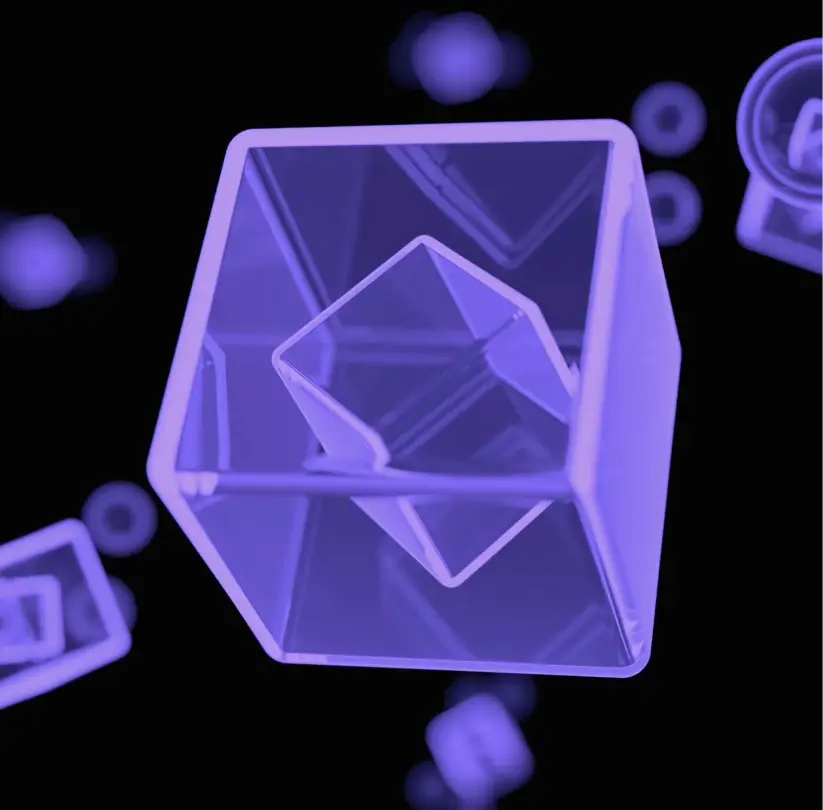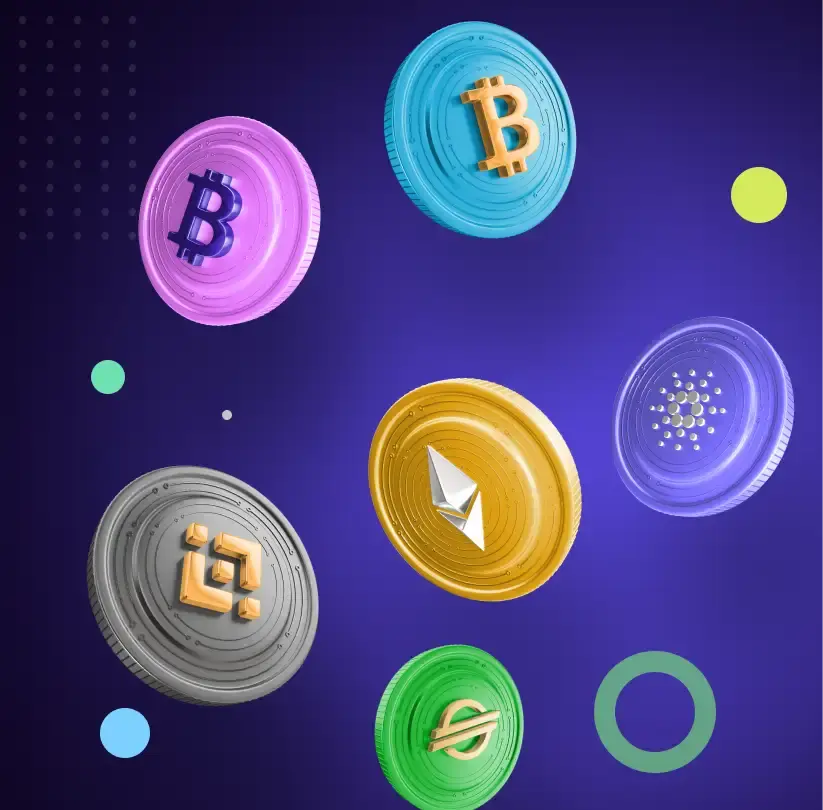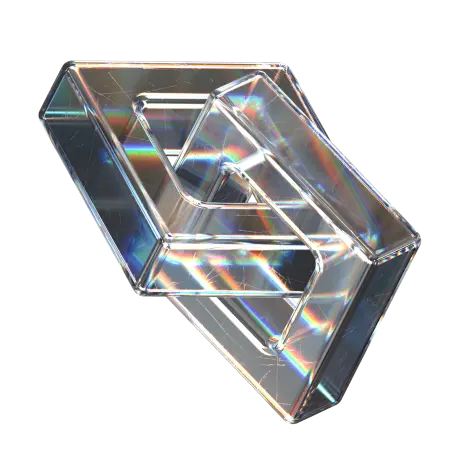Investors face several challenges in accessing traditional assets, including significant barriers to entry, regulatory and geographical limitations, and issues related to liquidity. RWA (real-world assets) tokens in the cryptocurrency space offer novel solutions to the challenges associated with traditional financial assets. What is an RWA meaning?
RWAs refer to tangible items—such as real estate, commodities, and collectibles—that are tokenized on the blockchain, facilitating greater liquidity and accessibility in the digital economy.
By linking physical assets to digital tokens, RWAs provide a way to integrate traditional financial systems with the innovative potential of blockchain technology.
In this brief, we will delve into the RWA crypto meaning, RWAs’ significance within the crypto space, and how they are poised to reshape our understanding of value in a rapidly digitizing world.
Let’s begin!
What are real-world assets (RWA)?
Interested in what is RWA in crypto? Real-world assets refer to a market where tangible assets are represented as tokens on a blockchain. These assets can include items like gold, fine art, real estate, and conventional financial instruments.
Tokenization transforms any physical asset into a digital form, enabling seamless transfers, enhanced liquidity, fractional ownership, and simplified storage— all without the need for intermediaries.

Tokens backed by RWAs can engage individuals who may not be well-versed in the decentralized finance (DeFi) ecosystem. RWAs are part of the traditional finance (TradFi) sector, which is characterized by strict regulations and intermediaries. Tokenization aims to integrate these assets into the decentralized landscape, expanding this emerging industry.
As of October 2024, the RWA sector’s market capitalization is valued at $6.921 billion.
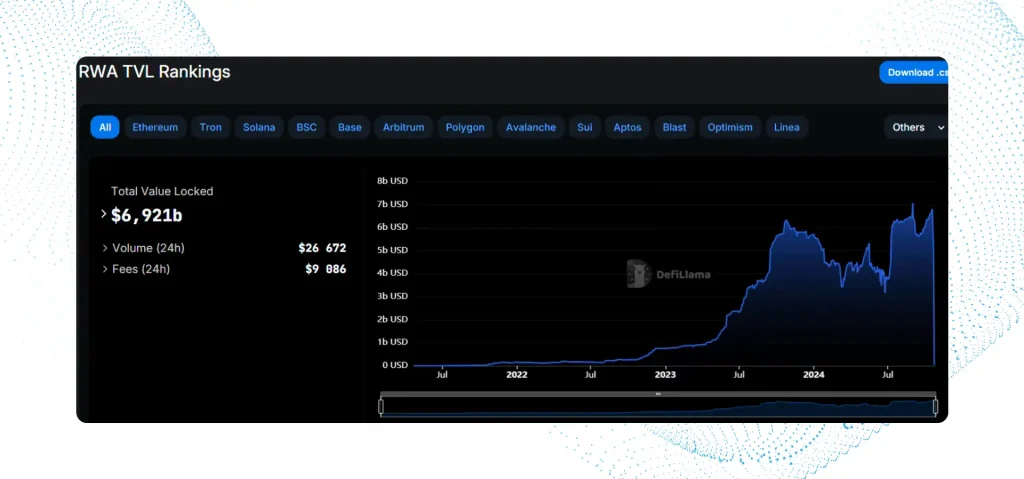
While this figure may seem modest, analysts anticipate substantial growth, projecting the sector could reach trillions of dollars in the coming years. According to Boston Consulting Group, the total capitalization of RWA could reach $16 trillion by 2030, encompassing a wide range of assets, including stocks, government bonds, real estate, and investment fund holdings.
Let’s explore what is RWA in crypto in greater detail.
The intersection of RWA and blockchain technology
This intersection not only addresses the limitations of traditional asset markets but also unlocks new options for investment and participation in the economy.
How blockchain enables RWA tokenization
Blockchain technology is an implacable part of the tokenization of real world assets.
By applying a transparent and decentralized ledger, blockchain enables the secure digital representation of physical assets as tokens. This transformation allows tangible items—such as art, real estate, and commodities (oil, gold) —to be converted into blockchain-based tokens that can be traded easily.
Each token acts as a verifiable claim on a portion of the underlying asset, ensuring clear and traceable ownership. Moreover, smart contracts streamline transactions. These contracts implement the agreed-upon terms directly, eliminating the necessity for intermediaries and simplifying the process while lowering expenses.
For example, one of the notable blockchain networks specifically designed for RWA tokenization is Polymesh. This RWA blockchain provides a secure platform for transforming physical assets like real estate and art into digital tokens, ensuring clear ownership rights and simplifying transfers.
Blockchain technology allows for the secure recording of transactions, making ownership and transaction history transparent and accountable. Polymesh further enhances this process with smart contracts that automate various transaction elements.
A major advantage of Polymesh is its focus on regulatory compliance, incorporating features like identity verification and KYC (know your customer) protocols to meet legal standards. This is particularly appealing to institutional investors seeking assurance about their investments.
Polymesh also facilitates fractional ownership, allowing multiple investors to share in high-value assets, thus broadening investment opportunities. By converting RWAs into digital tokens it also increases liquidity, enabling trading on compliant exchanges.
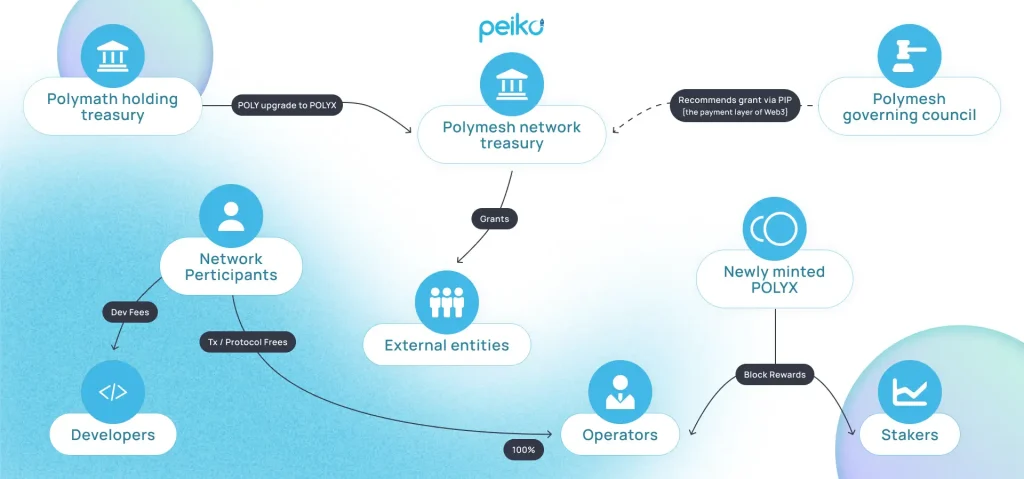
Benefits of tokenizing real world assets
Tokenizing RWAs brings numerous advantages, promoting transparency, enabling fractional ownership, and reducing transaction expenses:
Boosted liquidity
Converting physical assets into digital tokens significantly improves liquidity, allowing investors to purchase and trade assets on digital platforms more easily. This transformation breaks down the traditional barriers of the market, facilitating faster and more efficient trading and attracting a larger pool of participants.
Fractional ownership
A key advantage of tokenization is its capability to facilitate fractional ownership. This means multiple investors can own shares of high-value assets, such as real estate or fine art, which would otherwise be financially out of reach for many. By democratizing access to these investment opportunities, tokenization fosters inclusivity and broadens the investment landscape.
Enhanced transparency
Employing blockchain technology ensures a high degree of transparency, with all transactions permanently recorded and readily auditable. This level of visibility builds investor trust, allowing them to verify the history and ownership of assets without depending on intermediaries. Such transparency is crucial for attracting both institutional and retail investors alike.
Lower transaction costs
Tokenization can greatly lower transaction costs by removing intermediaries and streamlining processes using smart contracts. These automated agreements facilitate direct transactions between parties, cutting down on fees typically associated with brokers and middlemen. Consequently, asset trading becomes more economical and accessible to a wider audience.
Global accessibility
Blockchain technology establishes a borderless marketplace, enabling investors from anywhere in the world to engage with tokenized assets. This expanded reach not only increases the potential investor base but also presents new opportunities for asset owners seeking to attract global capital. A larger and more diverse investor pool can lead to improved asset liquidity and valuation.
Improved data privacy and ownership rights
Tokenization enables personalized privacy settings, giving asset owners the ability to specify who can view their information. This approach allows for selective confidentiality while adhering to compliance requirements, striking a harmonious balance between transparency and data protection in blockchain environments.
As you can see, the advantages of tokenization real world assets extend far beyond mere convenience.
Types of RWA in crypto
The crypto real world assets market is still in its early stages, but it has already begun to branch out into various categories that reflect the broader trend of tokenizing tangible assets.
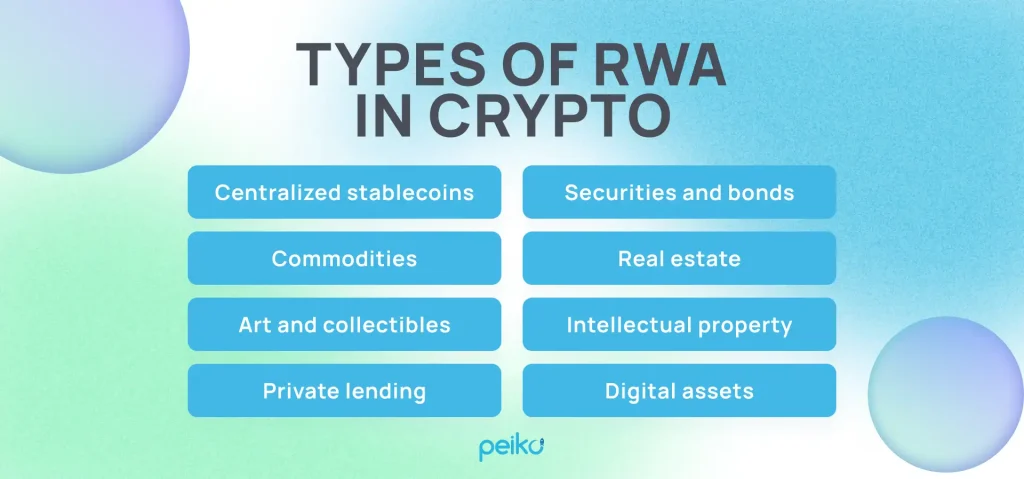
Centralized stablecoins
These stablecoins are digital currencies linked to stable assets, often fiat currencies like the US dollar. These stablecoins maintain a consistent value amidst the cryptocurrency market’s volatility, enabling users to transact with less risk.
Tokens like USDT from Tether and USDC from Circle qualify as RWAs because the companies behind them hold fiat currencies or government and commercial securities as collateral. These assets enable the issuance of stablecoins, essentially a form of real world tokenization.
Commodities
Tokenizing precious metals such as silver or gold provides a contemporary investment approach.
Companies like Paxos and Tether’s XAUT issue tokens backed by physical metals that are stored securely. This method enables easy buying, selling, and trading while preserving the intrinsic value of the metals. By leveraging blockchain technology, the process enhances transparency and liquidity for investors.
Art and collectibles
Represented by the NFT (non-fungible token) market, this category gained traction in 2021 when artists and collectors started tokenizing their creations. This approach allows for easier transactions and fractional ownership of high-value pieces. A notable example of such a purchase is when Justin Sun bought Picasso and Andy Warhol artworks as NFTs for $22 million.
Private lending
In private lending, platforms like MakerDAO utilize tokenization to provide decentralized lending solutions. MakerDAO, the creator of the DAI stablecoin, extended a $100 million credit line in tokens in 2022 to the American Huntingdon Valley Bank, earning interest on that amount.
These lending platforms allow users to borrow against their cryptocurrency holdings, bypassing conventional obstacles such as lengthy approval times and steep interest rates. This innovation streamlines lending and offers more flexible terms.
Securities and bonds
Tokenization is improving the process of the issuance and trading of securities and bonds. The USDM stable RWA coin on Ethereum, for instance, is backed by treasury bonds that generate a passive income of 5% annually. This category also includes the tokenization of shares from the stock market.
Real estate
The tokenization of real estate is revolutionizing the property investment field by transforming ownership into digital tokens. A good example of this trend has occurred in January 2023. Société Générale, a French multinational universal bank, and financial services company, borrowed $7 million in DAI from MakerDAO, using $40 million in mortgage bonds as collateral for the loan.
Intellectual property
Tokenization enables personalized privacy settings, giving asset owners the ability to specify who can view their information. This approach allows for selective confidentiality while adhering to compliance requirements, striking a harmonious balance between transparency and data protection in blockchain environments.
Digital assets
Real world asset tokenization can also convert previously centralized services into decentralized offerings. A case in point is Fragment, developed by the Telegram team, which allows users to buy and sell usernames, chats, and channels, securing ownership on the blockchain.
In this way, even Telegram channels can be tokenized. By distributing tokens among subscribers, a channel could effectively form a decentralized autonomous organization (DAO), where users have a vested interest in the channel’s growth and can participate in decision-making and management.
Use cases and applications of RWA in crypto
The integration of RWA real world assets into the cryptocurrency ecosystem is creating exciting use cases that enhance the functionality and accessibility of digital assets.
Increased liquidity for traditionally illiquid assets
Tokenizing RWAs unlocks liquidity for assets that have historically been difficult to trade, such as real estate or art. By converting these physical assets into digital coins, they can be easily bought or sold on blockchain platforms. This newfound liquidity not only enables quicker transactions but also opens up markets that were previously illiquid, allowing investors to realize value more rapidly.
Asset-backed lending
By tokenizing assets like real estate, borrowers can access liquidity without selling. This integration with decentralized finance allows users to use these assets as collateral, enhancing financial flexibility.
Smart contracts streamline the lending process, improving transparency and efficiency. Additionally, tokenized assets open global capital markets to more borrowers, creating a more inclusive financial ecosystem.
Fractional ownership
Tokenization facilitates fractional ownership of valuable assets, allowing several investors to hold portions of a single asset. This approach democratizes investment opportunities, enabling individuals to invest in assets they might not have been able to purchase outright. Fractional ownership enhances access to a wider range of investment options and improves portfolio diversification.
Cross-border transactions and investments
The decentralized nature of blockchain technology enables smooth cross-border transactions. Investors can easily buy or sell tokenized RWAs regardless of geographic location, reducing the barriers associated with traditional investing. This capability expands the pool of potential investors and enhances the market for RWAs, fostering global investment opportunities.
Collateralization in DeFi
In the decentralized finance (DeFi) space, RWAs can be applied as collateral for loans, creating new opportunities for liquidity and financing. For example, tokenized real estate or other physical assets can secure loans, allowing borrowers to access funds while retaining ownership of their assets. This innovative use of RWAs enhances the RWA DeFi ecosystem by integrating tangible value into financial transactions, thereby increasing trust and stability in the space.
Top RWA crypto projects in 2024
Several RWA crypto projects are emerging as leading ones in 2024, each bringing distinct solutions and innovations. Below, we have mentioned five notable RWA projects to keep an eye on. Let’s consider this RWA crypto list.
Ethena
RWA: Internet bonds
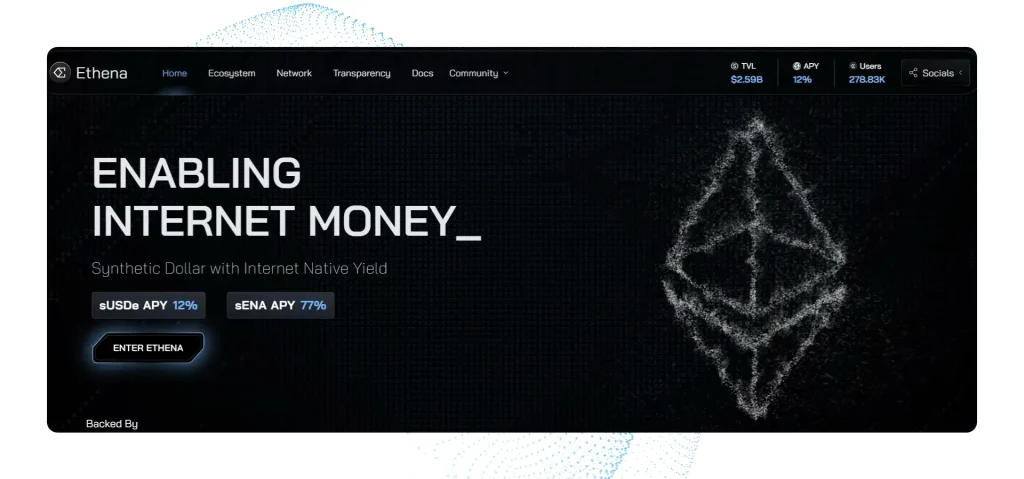
The first project in our RWA crypto list is Ethena. It is a platform that provides a stable RWA coin fully supported by a diversified portfolio of tokenized real world assets independent of traditional banking infrastructure. This creates a stable digital currency option for transactions and investments.
Operating on a decentralized protocol, Ethena ensures that no single entity controls the issuance and management of its stablecoin.
Users can leverage Ethena stablecoins across various DeFi applications—such as lending, borrowing, and liquidity provision—maximizing their utility in the expanding DeFi ecosystem. By depositing different assets as collateral, users can mint stablecoins while the platform continuously monitors and adjusts collateral ratios for stability.
Ondo Finance
RWA: Bonds and other fixed-income instruments

This one of the best RWA crypto projects focuses on tokenizing fixed-income assets, serving as a connection between traditional finance and the cryptocurrency landscape.
The platform provides a range of vault strategies, allowing investors to deposit assets and generate yield through various DeFi protocols. Ondo Finance controls these strategies to optimize returns while effectively managing risks. Utilizing a tokenized fund model, investors gain exposure to various assets and strategies via token representations, enhancing liquidity and easing entry and exit from investments.
MANTRA
RWA: Precious metals
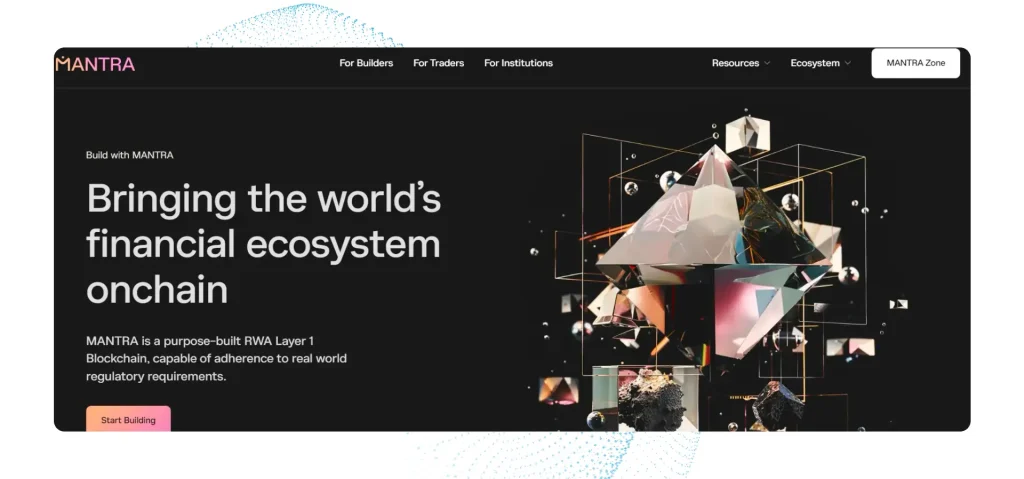
This is another successful project in our real-world assets crypto list. It is a Layer 1 blockchain focused on security and regulatory compliance, allowing for the tokenization of precious metals like gold and silver. This provides a stable store of value for crypto investors while facilitating DeFi applications.
Developed using the Cosmos SDK, MANTRA supports inter-blockchain communication, guaranteeing smooth interoperability with different blockchains. Capable of processing up to 10,000 transactions per second, it is well-suited for enterprise-level applications and high-frequency trading.
Pendle
RWA: Financial derivatives

Pendle is the next top project in our RWA crypto list. This platform is intended to tokenize financial derivatives. Pendle offers modern methods for trading and investing in these intricate instruments. It is compatible with several blockchains, including Ethereum, Arbitrum, BNB Chain, and Optimism, expanding its user base and liquidity.
Noted for its solid security and active community, Pendle enables users to separate and trade the principal and yield parts of their assets. This feature offers stability and flexibility in yield farming, enabling users to hedge their yield exposure or speculate on fluctuations. With options for fixed or variable yields, Pendle enhances the liquidity of yield-bearing assets.
Maple Finance
RWA: Loans and credit instruments
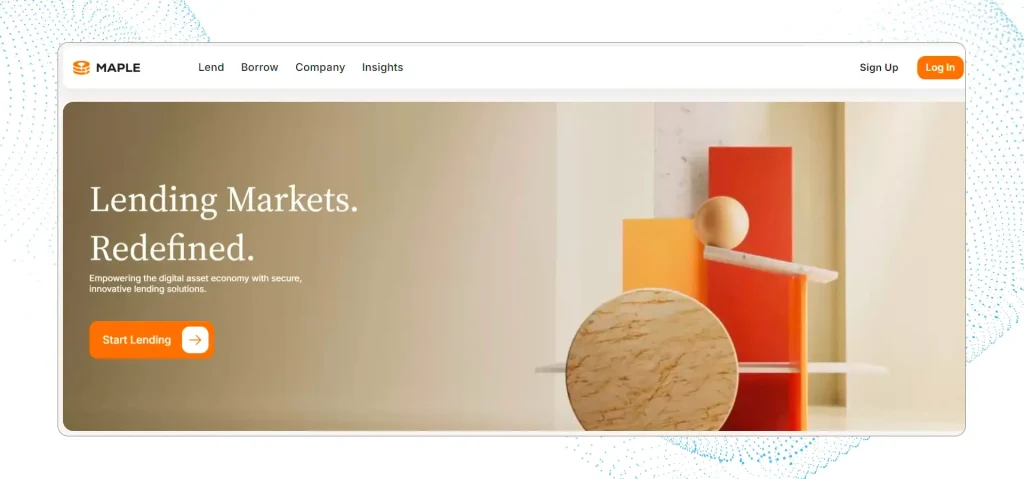
This project specializes in tokenizing corporate debt, offering businesses new ways to finance and fresh investment opportunities for individuals. The platform offers multiple lending pools tailored for institutional investors, including credit funds, corporate treasuries, and high-net-worth individuals.
To improve user experience and optimize operations, Maple collaborates with various service providers. This network encompasses secure wallet solutions like Coinbase Prime and Metamask Institutional, accounting and tax services from Bitwave, and qualified custodians such as BitGo.
The platform aims to utilize blockchain technology to enhance the accessibility and transparency of institutional credit markets.
For instance, Maple has introduced innovative products like Maple Cash Management, which offers stable income options, and expanded its lineup of on-chain financial solutions.
The future of RWAs in crypto
As the process of tokenizing physical assets continues to evolve, we can anticipate a redefinition of how value is managed, exchanged, and utilized across various sectors. Below are key points of what to wait for from crypto RWA development.
Potential impact on traditional finance
The incorporation of RWAs into the crypto realm could disrupt conventional financial systems by providing more efficient, transparent, and accessible alternatives for asset management. Tokenization facilitates fractional ownership, allowing a wider array of investors to engage in once-exclusive markets.
This democratization could compel traditional financial institutions to adapt their offerings or seek collaborations with blockchain platforms to remain relevant.
Emerging trends and innovations
A number of trends are starting to take shape in the RWA sector., particularly in the use of decentralized finance for lending and collateralization. As these protocols advance, we may witness new solutions for asset valuation and risk management.
Additionally, the development of regulatory frameworks will be crucial for fostering RWA adoption while ensuring compliance. Improved interoperability between blockchain networks will further enhance liquidity and expand investment options.
Predictions for RWA adoption and growth
In the coming years, the adoption of RWAs is likely to accelerate, fueled by growing awareness and acceptance of blockchain technology. As investors increasingly seek alternative asset classes and more efficient transaction processes, tokenized RWA could achieve mainstream status.
Experts forecast that the RWA market could grow into trillions of dollars over the next decade, driven by ongoing innovations in real world assets tokenization and DeFi. This expansion is expected to attract institutional investors, adding legitimacy to the sector and contributing to its overall development.
Regulatory compliance tools, including integrated KYC and anti-money laundering measures, are becoming commonplace. These developments enhance the appeal of RWAs to traditional investors and facilitate a connection between decentralized finance and centralized finance.
We can say that the outlook for RWAs in the crypto space is promising. This technology has the potential to transform traditional finance, inspire emerging trends, and facilitate substantial growth.
Peiko team is your best blockchain development partner
Peiko is a premier blockchain development firm focused on delivering cutting-edge solutions across various industries. Our team of expert developers, UX/UI (user experience/user interface) designers, and strategists helps businesses succeed with implemented blockchain technology.
Whether you’re aiming to create a new crypto exchange platform, build a crypto wallet, tokenize assets, or improve your current systems, Peiko offers the knowledge and assistance necessary to thrive in the fast-paced blockchain environment.
We have a vast portfolio that showcases our experience in blockchain development. Let’s consider one of our top projects.
Orion Protocol (ORN) is a decentralized blockchain platform that aggregates liquidity from both CEXs and DEXs (centralized and decentralized exchanges). Its primary goal is to provide cryptocurrency traders with the best trading rates, simplifying the process by allowing users to execute trades across multiple platforms from a single interface.
Originally envisioned as a basic crypto exchange, the project evolved into a sophisticated solution aimed at identifying the most advantageous trading routes, thus reducing costs and risks for users. Orion Protocol enhances the trading experience by consolidating liquidity from major exchanges like Binance and Uniswap while ensuring high security and performance.
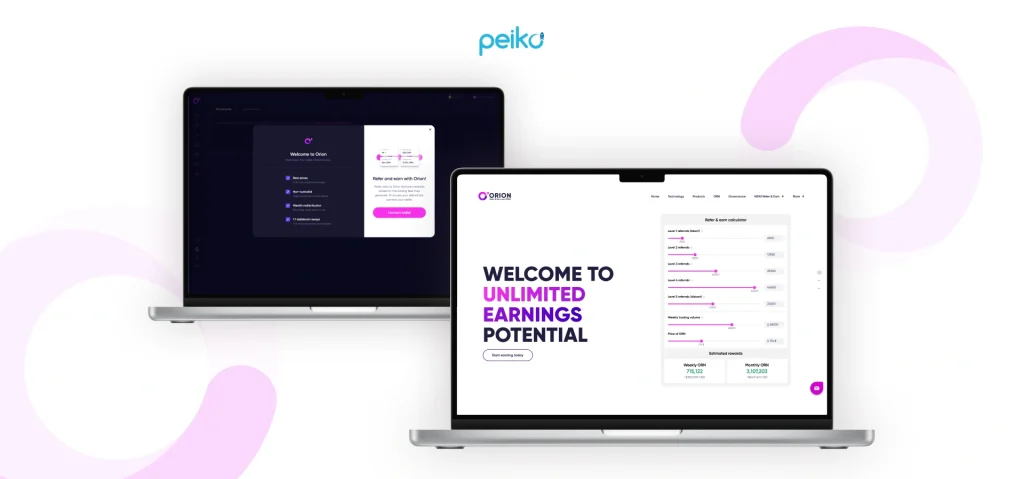
Key features we implemented for this blockchain project include:
- Non-custodial liquidity aggregator: This allows users to retain control over their assets while accessing a unified trading platform, minimizing the risk of losing funds.
- Crypto wallet integrations: The platform supports seamless connections with popular wallets like MetaMask and TrustWallet, enabling users to manage their assets directly within Orion.
- Orion Terminal: This central hub streamlines trading, allowing users to execute transactions efficiently without juggling multiple accounts.
- Advanced DEX features: By incorporating elements from both DEXs and CEXs, including transparent market data and TradingView integration, Orion enhances analysis and decision-making capabilities.
- Cross-chain transfers: The protocol supports efficient asset exchanges across various blockchains, such as Ethereum and Binance Smart Chain, expanding trading opportunities.
Built on a robust tech stack featuring Node.js and React, Orion Protocol is a robust and high-quality solution for liquidity aggregation and trading efficiency.
Conclusion
The merging of real-world assets and blockchain technology is creating exciting new opportunities in finance. By tokenizing RWAs, it becomes possible to improve liquidity and make investing more accessible, breaking down barriers that traditional finance has put up. With innovative projects like Ethena or MANTRA leading the way, the future for RWAs in the crypto world is bright.
As the RWA ecosystem evolves, it can change investment models and set new standards for both financial access and innovation in the digital economy.
If you’re inspired by the potential of RWAs crypto projects and want to bring your own blockchain project to life, look no further. Turn to Peiko for expert blockchain development services tailored to your vision. Contact us, and our specialists will help you implement your ideas into reality.



